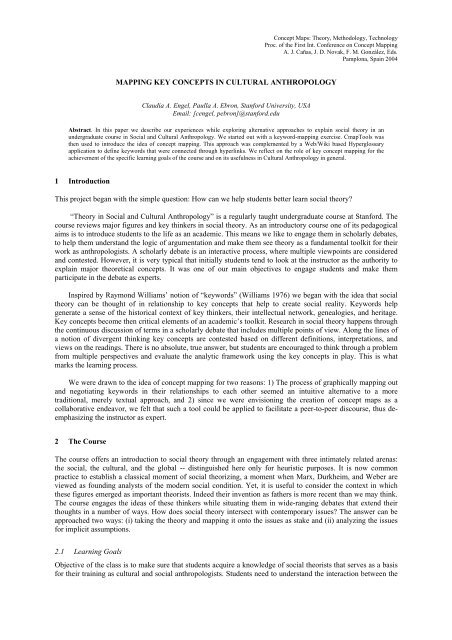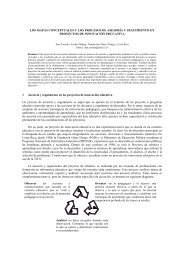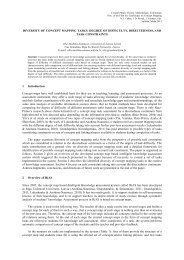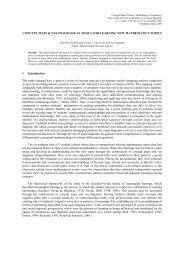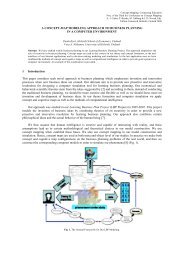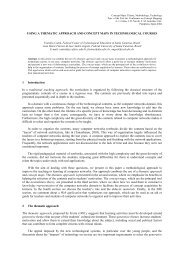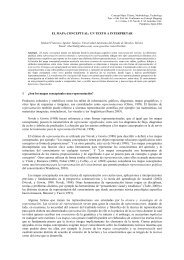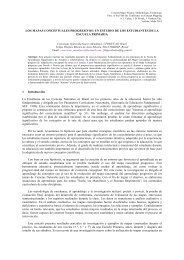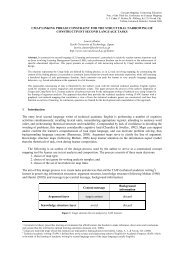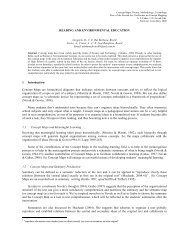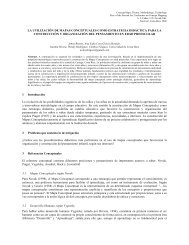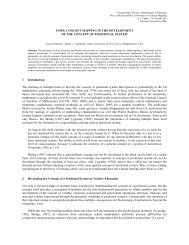MAPPING KEY CONCEPTS IN CULTURAL ANTHROPOLOGY 1 ...
MAPPING KEY CONCEPTS IN CULTURAL ANTHROPOLOGY 1 ...
MAPPING KEY CONCEPTS IN CULTURAL ANTHROPOLOGY 1 ...
You also want an ePaper? Increase the reach of your titles
YUMPU automatically turns print PDFs into web optimized ePapers that Google loves.
Concept Maps: Theory, Methodology, TechnologyProc. of the First Int. Conference on Concept MappingA. J. Cañas, J. D. Novak, F. M. González, Eds.Pamplona, Spain 2004<strong>MAPP<strong>IN</strong>G</strong> <strong>KEY</strong> <strong>CONCEPTS</strong> <strong>IN</strong> <strong>CULTURAL</strong> <strong>ANTHROPOLOGY</strong>Claudia A. Engel, Paulla A. Ebron, Stanford University, USAEmail: [cengel, pebron]@stanford.eduAbstract. In this paper we describe our experiences while exploring alternative approaches to explain social theory in anundergraduate course in Social and Cultural Anthropology. We started out with a keyword-mapping exercise. CmapTools wasthen used to introduce the idea of concept mapping. This approach was complemented by a Web/Wiki based Hyperglossaryapplication to define keywords that were connected through hyperlinks. We reflect on the role of key concept mapping for theachievement of the specific learning goals of the course and on its usefulness in Cultural Anthropology in general.1 IntroductionThis project began with the simple question: How can we help students better learn social theory?“Theory in Social and Cultural Anthropology” is a regularly taught undergraduate course at Stanford. Thecourse reviews major figures and key thinkers in social theory. As an introductory course one of its pedagogicalaims is to introduce students to the life as an academic. This means we like to engage them in scholarly debates,to help them understand the logic of argumentation and make them see theory as a fundamental toolkit for theirwork as anthropologists. A scholarly debate is an interactive process, where multiple viewpoints are consideredand contested. However, it is very typical that initially students tend to look at the instructor as the authority toexplain major theoretical concepts. It was one of our main objectives to engage students and make themparticipate in the debate as experts.Inspired by Raymond Williams’ notion of “keywords” (Williams 1976) we began with the idea that socialtheory can be thought of in relationship to key concepts that help to create social reality. Keywords helpgenerate a sense of the historical context of key thinkers, their intellectual network, genealogies, and heritage.Key concepts become then critical elements of an academic’s toolkit. Research in social theory happens throughthe continuous discussion of terms in a scholarly debate that includes multiple points of view. Along the lines ofa notion of divergent thinking key concepts are contested based on different definitions, interpretations, andviews on the readings. There is no absolute, true answer, but students are encouraged to think through a problemfrom multiple perspectives and evaluate the analytic framework using the key concepts in play. This is whatmarks the learning process.We were drawn to the idea of concept mapping for two reasons: 1) The process of graphically mapping outand negotiating keywords in their relationships to each other seemed an intuitive alternative to a moretraditional, merely textual approach, and 2) since we were envisioning the creation of concept maps as acollaborative endeavor, we felt that such a tool could be applied to facilitate a peer-to-peer discourse, thus deemphasizingthe instructor as expert.2 The CourseThe course offers an introduction to social theory through an engagement with three intimately related arenas:the social, the cultural, and the global -- distinguished here only for heuristic purposes. It is now commonpractice to establish a classical moment of social theorizing, a moment when Marx, Durkheim, and Weber areviewed as founding analysts of the modern social condition. Yet, it is useful to consider the context in whichthese figures emerged as important theorists. Indeed their invention as fathers is more recent than we may think.The course engages the ideas of these thinkers while situating them in wide-ranging debates that extend theirthoughts in a number of ways. How does social theory intersect with contemporary issues? The answer can beapproached two ways: (i) taking the theory and mapping it onto the issues as stake and (ii) analyzing the issuesfor implicit assumptions.2.1 Learning GoalsObjective of the class is to make sure that students acquire a knowledge of social theorists that serves as a basisfor their training as cultural and social anthropologists. Students need to understand the interaction between the
top of each other to create a layered, quasi 3-dimensional representation or the introduction of images (tree) asmetaphorical visualization.3.2 Defining keywords: the Collaborative HyperglossaryBased on this experience we parted initially from the idea of having students collaboratively edit and discussdifferent definitions of keywords. For that reason we started out searching for a Web based collaborative editingenvironment, which led to using a Wiki application (Twiki - A Web Based Collaboration Platform fromhttp://twiki.org), very much alike Wikipedia (http://en.wikipedia.org/wiki/Main_Page), an online collaborativedictionary. The interface provides an easy way to publish simple webpages that can be interlinked, and theunderlying philosophy of Wikis as an open environment allows anyone to edit and comment on any pages.We adapted the tool to our specific needs, and designed it as a collaborative online hyperglossary. The"Hyper-Glossary of Cultural Terms" (Fig.2) allows users to simply edit and upload definitions and comments onkey terms. Each key term is described on a different Web page. Multiple hyperlinks between can connectbetween the different pages, thus creating a hyperlinked network of related terms.Figure 2: Collaborative Hyperglossary (front page and example of keyword definition)The glossary can evolve and grow continuously over time around keywords and their contested definitions.We meant to have the students experience that there was not one correct definition and to motivate them to beresponsible and create strategies on how to do their own research on the topics. A collective list of key termsthat would allows students to appreciate ways certain terms is used to frame arguments and debates. We did notsuggest any key concepts nor provide a list, but encouraged students to determine on their own which keyconcepts they would select based on their reading of the course material.Because of time constraints and availability the hyperglossary could only be introduced later during thecourse. This tool was used mostly by students and less by the instructor. Even though we were concerned thatthere would be too much of a learning curve to understand the technology and rules of how to create pages andhyperlinks it was quickly adopted by students. Most of the activity in the hyperglossary happened outside theclass.In addition to the hyperglossary we considered a different application that would allow to map key conceptsmore visibly in a two-dimensional space and visualize relations graphically. Therefore we chose CmapTools(from IHMC CmapTools Knowledge Modeling Kit. http://cmap.ihmc.us/).3.3 Representing theory: CmapCmap was first introduced through the instructor and used by her to present a summary and a context forreadings for particular seminar sessions. Mapped out were relationships between key thinkers, their historicalcontext and influences, as well as connections to other readings (see Fig.3). The Cmap was uploaded to theIHMC server, where we set up a folder with restricted access. Hardcopies were printed and taken to class.
Students usually annotated those individually and took notes during the introduction of the readings anddiscussion.After a few sessions students started adapting their way of working with the readings to a similar practice.Each session had designated discussants to prepare and guide the conversation of the assigned readings.Interestingly it was the idea of mapping out key concepts that was appealing, not the use of the CmapTools perse. Students typically provided an introduction and prepared a list of questions to get the conversation going.Later they started using the blackboard to write down key terms they themselves found relevant. The wholeclass would then contribute to the keywords and elaborate connections between the terms. The use of theCmapTools software in that whole process was only marginal.Figure 3: Concept Map: Introduction to readings from Emile Durkheim4 Reflections4.1 Comparison of the toolsTable 1 summarizes the differences that deemed relevant for our experience in the use of the two tools.As the table shows, both tools are distinctly different in a number of characteristics. It was part of ourexperimental approach to try to use both instruments complementary and thus be able to take advantage of thestrengths of both of them. While there are disadvantages to use two different systems, and while apparently thevisual potential of Cmap was very appealing to the students and instructor we also felt that Cmap alone wouldnot provide all the features we were looking for. For example, we wanted to promote interaction for the wholegroup outside of the classroom, and for some students installing the software did present a hurdle.More elaborate versions of a combined approach of representing knowledge in an interconnected way, bothvisually and textually exist. One example is the Visual Thesaurus, where terms are connected in a 3-dimensionalrepresentation through different line types with different meanings, where proximity plays a role and a textualrepresentation is included as well (http://www.visualthesaurus.com/online/index.html).
CmapHyperglossary• Graphical/visual• Potentially hierarchical structure• More focus on relationships• Links are visible lines• Client needs to be installed, PC only• Offline use possible• Collaboration happened face to face (in class)• Textual/hypertextual• Non hierarchical structure• More focus on definitions• Links are (virtual) hyperlinks• Access through web browser, any OS• Can be accessed online only• Interaction with the tool remotely, outside classTable 1: Comparison Cmap vs. Hyperglossary4.2 Value of key concept mapping for the courseReading and writing as typically individual activities and in-class discussion as potentially interactive are thetraditional techniques used in cultural theory courses. With key concept mapping as a technique to approach thecomplexity of social theory we deliberately chose an approach radically different from conventional teachingpractices in our department.Cmap allowed for a genuinely different way of re-presenting and interacting with the textual material, whilethe Hyperglossary, even though built around the notion of keywords and potentially more collaborative, stillmight come closer to a conventional approach of writing. Inspired by the instructor using Cmap representationsfor her introductory comments, key concept mapping was picked up quickly by the students as an appealingalternative that highly motivated the group to interact with the assigned texts.We also believe that the technique of starting out with a collection of keywords in a more informal way,almost similar to a brainstorming session, helped support certain leaning styles and most likely include morestudents in the class activities. We observed two very silent students who were coaxed out of silence by thetechnique. Maybe keyword mapping created a less formal and threatening atmosphere. Students could justthrow out ideas - "I think X is an interesting word" or "The author uses the expression X and I don't know whatit means", which then would become subject of the group debate.In addition, and somewhat independent from the actual tool, we think that the collaborative aspect had quitean impact on students’ perception of the class. The key concept mapping activities turned into an ongoinggenerative process. All participants were building something together with the potential to even re-use thematerial in subsequent courses.Taking all this together and comparing it with earlier versions of the class this one allowed us to watchstudents transform from passive consumers to active participants in the achievement of their educational goals.In various conversations following the class students stated that they now see keyword mapping as a useful toolto help them approach certain theoretical domains and approach difficult reading material. Other instructors atthe department became interested and Cmap was subsequently been used in a graduate Archaeology class onmateriality.4.3 Use of concept maps for understanding cultural anthropologyConcept mapping originated from the natural sciences (Novak 1998) and has been used exhaustively inplanning, engineering, and assessment. Fewer applications from the social sciences are known, for examplepsychology (Jacobs-Lawson and Hershey 2002) or sociology (Trepagnier 2002). However, concept mappingcan be of high potential value for theoretical domains where relations between concepts are often abstract andthere can potentially be multiple connections (Trepagnier 2002, p.108). Specifically for the domain of culturalanthropology Raymond Williams’ idea about keywords, resonates quite well with the notion of “mapping” ofkey concepts. He was trained as a literary scholar.
In fact, an important component of our approach is the relationship between concepts and words. Murphy(2002) in a recent comprehensive review of the research around concepts dedicates an entire chapter to “Wordmeaning” where he tries to argue for a specific relation between the process of making meaning of words in thecontext of concepts. For him “Words gain their significance by being connected to concepts” (Murphy 2002, p.385). This, we believe, comes close to our perception of keywords and how we try to have students makemeaning at the intersection of linguistics, discourse, and concepts - concepts understood as a collective term thatbrings together a number of ideas of a new field, still largely unknown to them.Parting from the notion of “good scholarship” we may ask what it involves. Oftentimes, making anargument is important piece of it, something we are not sure key concept mapping alone can provide.Collaborative tools for computer-supported visualization of arguments (Kirschner et al 2003) might be analternative to consider.While generating a list of key concepts is relatively easy, a more difficult task during concept mapconstruction is to find the “linking phrase” that appropriately expresses the relationship between two concepts toform a meaningful proposition. Concept maps are graphs that are comprised of concepts (defined by Novak1998 as perceived regularities in objects and events). Social research in the 20th century can be broken downinto several categories that are interrelated, contemporary, and that influence each other, like "kinship"networks, genealogies, schools, key concepts, and key players. Concepts and debates in social theory might bemore controversial and complex than a concept map may convey. While under certain conditions it may beuseful to simplify, on other occasions it may be detrimental, because too many implicit assumptions have to bemade which can distort the representation.Again, we ask: what does that mean for social theory? In addition to having possible multiple ways ofmapping, oftentimes relations between key terms have meanings like ‘context’, ‘situated’, ‘influenced by’,‘awareness’, all of those relatively unspecific connections, and it is not clear if it is it always possible to qualifyconnections. Is it useful to ‘force’ students to think about qualifying the connections between concepts? Here adifferent tool like the hyperglossary may have its advantages as connections don’t have to be specified.While it is clear that the concept maps produced in our class do not necessarily involve a hierarchicalstructure our approach is coherent with the underlying learning theory that learning takes place by theassimilation of new concepts and propositions into existing concept propositional frameworks held by thelearner, and thus promotes meaningful learning (Ausubel 1963). However, for reasons of consistency it might bemore appropriate to apply the term “topic maps” rather than concept maps.The project presented here was meant to be an experimental pilot study to explore tools and innovativeapproaches that would allow us to apply the notion of keywords and key concepts and work with theoreticaltexts and contents in a non-conventional way. We don’t have any direct evidence about how our interventioninfluenced the learning process other than seeing students motivated, more engaged and seeing them use thetechnique not only in other classes, but also for their own research projects. As usual in these cases, we havegenerated more questions than answers. However, we are intrigued by their potential for alternative approachesto academic scholarship.5 ReferencesAusubel, D. P. (1963). The Psychology of Meaningful Verbal Learning. New York: Grune and Stratton.Jacobs-Lawson, J. M. and D. A. Hershey (2002). Concept Maps as an Assessment tool in Psychology Courses.Teaching of Psychology, 29 (1), 25-29.Murphy, G. L. (2002): The big book of concepts. Cambridge, Mass. MIT Press.Novak, J. D. (1998). Learning, creating, and using knowledge: Concept Maps as Facilitative Tools in Schoolsand Corporations. Mahweh, NJ: Lawrence Erlbaum Associates.Kirschner, P. A., S. J. Buckingham Shum and C. S. Charr (eds.) (2003). Visualizing Argumentation. SoftwareTools for Collaborative and Educational Sense-Making. London: Springer.Trepagnier, B. (2002). Mapping sociological concepts. Teaching Sociology, 30,108-119.Williams, R. (1976). Keywords: A Vocabulary of Culture and Society. New York : Oxford University Press.


